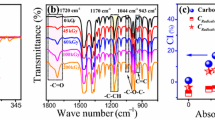Abstract
The influence of γ-irradiation on the structure and some mechanical properties of poly-β-hydroxybutyrate was studied. Specimens of PHB were γ-irradiated with various doses (1–20 Mrad) in air and vacuum. The molecular weight, structural characteristics of the crystalline and amorphous phases, characteristics of thermal degradation, and deformation of the polymer were determined. The crystallinity was found to increase with increase in the radiation dose and with the corresponding reduction in molecular weight. The increase of crystallinity was the greater the smaller the length of macromolecules (higher radiation dose). The melting temperature T m , which characterizes the crystalline order, decreased with decrease in the molecular weight. The results of calorimetric studies suggest that radiation-caused degradation, which occurs at a temperature at which “cold” crystallization (60°C) is possible, might also affect the crystalline part of the polymer.
Similar content being viewed by others
References
G. J. L. Griffin, Chemistry and Technology of Biodegradable Polymers, Chapman & Hall, Glasgow (1994).
E. M. Stegantseva, L. Savenkova, and Y. H. Park, “Effects of nitrogen and oxygen supply on production of poly-β-hydroxybutyrate inAzotobacter chroococcum,” J. Microbiol. Biotechnol.,5, No. 2, 100–104 (1995).
W. Babel, V. Riis, E. Hainich, “Mikrobielle Thermoplaste: Biosynthese, Eigenschaften und Anwendung,” Plaste und Kautschuck,37, No. 4, 109–115 (1990).
R. Langer, L. G. Cima, J. A. Tamada, and E. Wintermantel, “Future directions in biomaterials,” Biomater.,11, November 738–745 (1990).
E. Piskin, “Biodegradable polymers as biomaterials,” Rev. J. Biomater. Sci., Polymer Ed.,6, No. 9, 775–795 (1994).
D. Jendrossek, A. Schirmer, and H. G. Schlegel, “Biodegradation of polyhydroxyalkanoic acids,” Appl. Microbiol. Biotechnol.,46, 451–463 (1996).
F. D. Kopinke, M. Remmler, and K. Mackenzie, “Thermal decomposition of biodegradable polyesters. I: Poly(β-hydroxybutyric acid),” Polym. Degrad. Stabil.,52, 25–38 (1996).
Y. Doi, Y. Kanesawa, Y. Kawaguchi, and M. Kunioka, “Hydrolytic degradation of microbial poly(hydroxyalkanoates),” Makromol. Chem., Rapid Commun.,10, 227–230 (1989).
C. Collett, M. Buggy, and G. G. Henn, “Irradiation of poly-D,L-lactide,” Polym. Degrad. Stabil.,38, 249–253 (1992).
N. D. Miller and D. F. Williams, “On the biodegradation of poly-β-hydroxybutyrate (PHB) homopolymer and poly-β-hydroxybutyrate-hydroxyvalerate copolymers,” Biomater.,8, 129–137 (May, 1987).
M. Spenlehauer, M. Vert, J. P. Benoit, and A. Boddaert, “In vitro and in vivo degradation of poly(D,L lactide/glycolide) type microspheres made by solvent evaporation method,” Biomater.,10, 551–563 (October, 1989).
D. Hutmacher, M. B. Hurzeler, and A. Kirsch, “The effects of gamma and ethylene oxide sterilization on different bioresorbable polymers” in: 5th World Biomater. Congr., Toronto, Canada (1996).
P. J. Barham and H. H. Keller, “The relationship between microstructure and mode of fracture in polyhydroxybutyrate,” J. Polym. Sci.: Polym. Phys. Ed.,24, 69–77 (1986).
P. J. Barham, H. H. Keller, J. Martinez-Salazar, and M. Sanchez-Cuesta, “Thermal expansion and spherulite cracking in 3-hydroxybutyrate/3-hydroxyvalerate copolymers,” J. Mater. Sci. Lett.,8, 490–492 (1989).
F. Biddlestone, A. Harris, J. N. Hay, and T. Hammond, “The physical ageing of amorphous poly(hydroxybyrate),” Polym. Int.,39, 221–229 (1996).
S. Bruckner, S. V. Meille, and L. Malpezzi, “The structure of poly(D-(−)-β-hydroxybutyrate). A refinement based on the Rietveld method,” Macromolecules,21, No. 4, 967–972 (1988).
R. Pearce and R. H. Marchessault, “Multiple melting in blends of isotactic and atactic poly(β-hydroxybutyrate),” Polymer,35, No. 18, 3990–3997 (1994).
J. H. O'Donnell and C. A. Smith, “Evaluation of radiation chemical yields from the reciprocal relationship between irradiation dose and weight-average molecular weight,” J. Polym. Sci.: Polym. Phys. Ed.,16, 1515–1518 (1978).
J. H. O'Donnell, C. W. Frank, and E. Reichmanis, Irradiation of Polymeric Materials, Amer. Chem. Soc., Washington (1993).
V. S. Ivanov, Radiation Chemistry of Polymers [in Russian], Khimiya, Leningrad (1988).
Additional information
Institute of Polymer Materials, Riga Technical University, Riga, LV-1048, Latvia. Translated from Mekhanika Kompozitnykh Materialov, Vol. 35, No. 2, pp. 239–252, March–April, 1999.
Rights and permissions
About this article
Cite this article
Bibers, I., Kalnins, M. Control of biopolymer poly-β-hydroxybutyrate characteristics by γ-irradiation. Mech Compos Mater 35, 169–178 (1999). https://doi.org/10.1007/BF02257247
Received:
Revised:
Issue Date:
DOI: https://doi.org/10.1007/BF02257247




